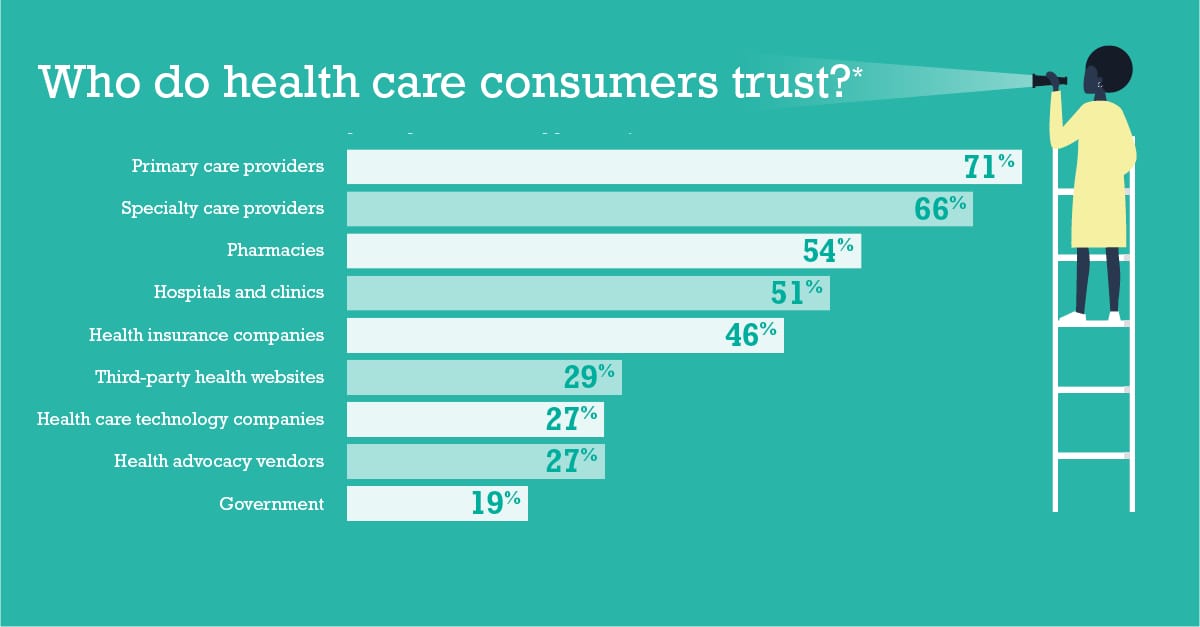The headlines these days are packed with stories of surprise medical bills and calls for more healthcare cost transparency. It makes sense. People want more control over their rising healthcare costs. Health plans, providers, employers and even the federal government are working to improve the situation for consumers, but there remains a large divide between where we are today and where we want to be. Because we partner with health plans that work hard to help their members navigate and understand healthcare, we undertook a research effort to understand the consumer’s point of view on the healthcare industry and transparency.
HealthSparq partnered with Hanover Research, an independent research and analytics firm, to survey nearly 1,000 (991 to be exact) Americans on their experiences with the healthcare industry and their engagement with healthcare cost transparency tools. Our report is a snapshot of where consumers stand when it comes to their level of trust in the healthcare system, frequency of communication they prefer, and what level of personalization they are comfortable with – all to help understand where the industry is still falling short when it comes to transparency. The results revealed some stark reminders for the healthcare industry, especially when viewed in the context of the current national conversation around healthcare transparency and surprise medical bills. Here is what we found.
Many consumers don’t know basic information about their healthcare coverage
It’s hard to have control over something that you don’t understand.
 The HealthSparq 2019 Consumer Sentiment Benchmark Study found that less than half of consumers (47%) state they are very or extremely confident with their understanding of their insurance coverage and benefits and just over half (51%) feel that level of confidence around a core aspect of their insurance: their deductible. Furthermore, despite some state laws mandating healthcare search and transparency tools, 46% of Americans still don’t know if their health plan offers them. Ranging from information on providers and procedure costs, treatment option resources, to covered benefit guidance, these tools are cornerstones of patient empowerment.
The HealthSparq 2019 Consumer Sentiment Benchmark Study found that less than half of consumers (47%) state they are very or extremely confident with their understanding of their insurance coverage and benefits and just over half (51%) feel that level of confidence around a core aspect of their insurance: their deductible. Furthermore, despite some state laws mandating healthcare search and transparency tools, 46% of Americans still don’t know if their health plan offers them. Ranging from information on providers and procedure costs, treatment option resources, to covered benefit guidance, these tools are cornerstones of patient empowerment.
Without closing both the healthcare literacy gap along with the healthcare transparency awareness gap, an uphill battle remains in helping people control healthcare costs and reduce the likelihood of surprise medical bills.
Missed connection: Healthcare’s communication problem
Would you listen to what a stranger told you to do? Not likely. Yet, that is what many health plans are to their members. Our study revealed that a third of health plan members only hear from their health plan once a year or less via the channels they prefer most: email or direct mail. A previous HealthSparq survey found that members want more contact, several times per year or even monthly, from their health plan. Touching base more frequently supports members’ health literacy and awareness of their plan’s resources. And yes, you read the above correctly, despite the proliferation of communication options available today, ranging from apps to chatbots to smart speakers, people still overwhelmingly chose email as their preferred method of communication for hearing from their health plan.
The doctor’s office: A powerful place to advance transparency
When it comes to healthcare cost transparency – physicians are in a strong position to help raise awareness and educate their patients about healthcare. Why? People trust their physician. In fact, 81% of respondents said a recommendation from their primary care physician was highly likely to influence their healthcare decisions, compared to 58% if the recommendation came from their health plan’s customer service or transparency tool. Furthermore, 67% of consumers say they are more likely to use a healthcare transparency tool if their physician recommends it.
Government, payers and others who want to advance transparency in healthcare have much to gain from this hugely valuable – and trusted – resource. Working with physicians to help them find, understand, and share costs with their patients, educate them about what their insurance benefits mean, and participate in open conversations about healthcare costs and transparency might move the needle on closing the gap in education and awareness.
Make it personal
Today’s consumers expect personalization with every interaction – even in healthcare. More than half of survey respondents with access to healthcare transparency tools said they would trust these tools more if they provided meaningful personalization based on their medical history, out-of-pocket costs and provider relationships.
Our survey found that:
- 79% of respondents would be comfortable with health plans using their personal information to make healthcare recommendations
- 60% of respondents would appreciate if their health plan contacted them after provider visits to promote providers with lower rates for similar claims
- 59% of consumers would appreciate their health plan identifying diabetes risk and recommending strategies for prevention
- 54% of respondents would value personalized messaging or tasks based on recent activity, e.g. leave a review, special offers, etc.
Ultimately, consumers are more likely to act on information that is tailored to their unique circumstances. Gaining an understanding of what matters most and what information they find valuable—and in what context—is one way to support consumers with healthcare decisions and trusting recommendations.
While healthcare cost and quality transparency issues dominate the national discourse and federal policies to curb healthcare spending are introduced, the demand for these resources among health plans, government groups and consumers themselves will continue to grow. We’re committed to help people take charge of their health decisions and promote transparency in healthcare. To download the full report and review all the findings, click here.

